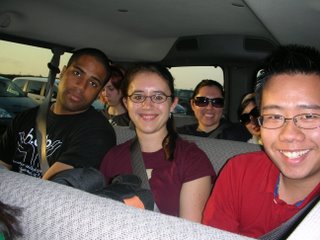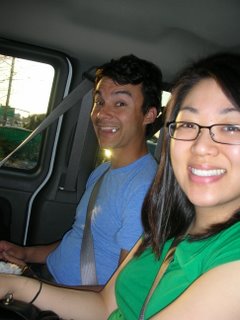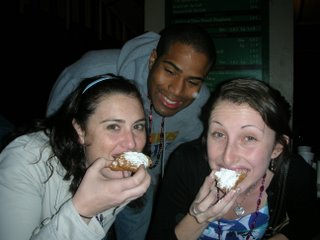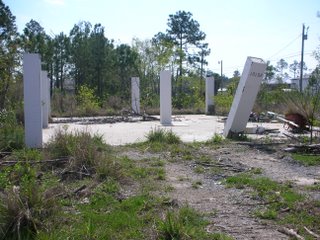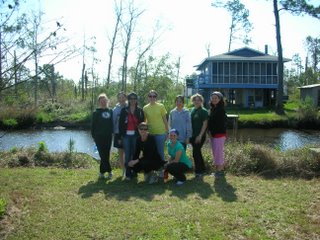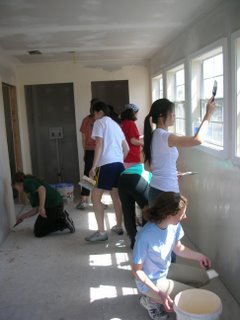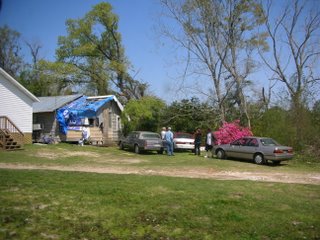Blog Editors
Recent Posts
20 March 2012 – Saint George Day 2: On Medicaid and Zion National Park
19 March 2012 – Saint George Day 1: Utah Legal Services at the Southern Utah Community Legal Center
18 March 2012 – To Saint George, Seven of Us Go!
17 March 2012 – HALO Departs for Spring Break 2012!
Archive
The Politics of Rebuilding
Posted By Lorin Kline, Mar 24, 2008
I expected to be surprised when we arrived. Not only have I never been to the South, I've never been anywhere hit by a hurricane. I've seen the pictures, the footage, heard the sad stories. But coming down here and seeing how complete the destruction is almost three years after the storm hit, changes your mind. And speaking personally to anyone who was here when the storm hit and, more importantly, has been here for the aftermath changes the way you feel about the issues permanently.
We arrived on Saturday and started our trip by exploring the gulf coast region before having to start our legal work on Monday. We flew into New Orleans then drove down the gulf coast to Gulfport, Mississippi to the church where we are staying. We spent Sunday driving through some gulf coast towns in Mississippi, and went back to New Orleans on Sunday night for an orientation with our sponsoring organization, the Student Hurricane Network. Then we were able to explore a little bit of New Orleans, including Bourbon Street and the French Quarter, making an effort to sample some of the local culture and cuisine before venturing back to our home base in Gulfport.
Something I learned very quickly about the hurricane damage is that while it affected areas all over the gulf coast, it affected everywhere differently. In New Orleans, as we drove down the freeway, at first glimpse nothing looks too amiss. It actually reminded me of driving toward the river into downtown St. Louis. We saw the infamous SuperDome and plenty of tall buildings. When you take a closer look, though, you see that while many buildings are still standing, they are completely gutted. Some things have clearly been rebuilt, but many buildings, from the biggest skyscrapers to the smallest homes, are still completely hollow. It is very eerie. The smaller gulf coast towns, on the other hand, look entirely differently. We drove through towns such as Biloxi, Gulfport, Bay St. Louis, and Pass Christian, and they just look completely decimated. Nothing is left. Rather than buildings being gutted and standing like hollow skeletons, most everything in Mississippi was simply swept away leaving nothing behind. It reminded of me of seeing areas ravaged by forest fire. Foundations that once held up homes just stand alone. The extent of the damage didn't even really hit me until today when we were told that the long highway that we drive down (which goes right along the beautiful, white sandy beach) was once lined with a number of strip malls. Now it is just empty. It's truly unbelievable.
What is more unbelievable than anything else is that the storm happened almost three years ago, and it looks like it couldn't have been more than three months. After hearing all of the press about Katrina and hearing the optimistic updates about how people have "pulled themselves up by their bootstraps" (words spoken by the governor of Mississippi), I didn't expect things to look as do. But they still look awful.
It seems simple to me. You just rebuild. But I learned this weekend that rebuilding is far from simple.
We spent Easter Sunday volunteering with an organization called Restoration Point. They funnel volunteers into the gulf coast region to help rebuild homes. We spent the day painting what will soon be a new kitchen in a new house for a man whose home was destroyed, and it was definitely a positive experience. What was more interesting, though, was to hear the leader at Restoration Point, a man named Jim, talk about the storm coming in, the chaos that ensued, and continues to ensue. He told us about how so many nonprofits and faith-based organizations have come in, along with government aid, all with their own idea of the best way to rebuild and start over. He expressed frustration about a lack of accountability among organizations, a lack of a cohesive plan, and all of the trouble it has caused. I had never considered the politics involved when so many people have been affected and so many people are trying to help. You wouldn't think so many people trying to give their time and support could be a bad thing, but it seems to be a case of too many cooks spoiling the broth. Not too many cooks really, because much more help is needed, but just every cook insisting on his own recipe.
Jim proclaimed himself to us as a conservative Republican. This shocked me. Most people in social services in general tend to be liberal. I would have bet money that he was a liberal Democrat after hearing him talk to us. He added to my shock by saying that he thinks the federal government and FEMA did all that they could do in response to the disaster. This is not a commonly held opinion, on either side of the political divide. He was blaming the parade of people that have come, or not come, after FEMA. I never would have imagined that someone so passionate about the relief effort would feel this way. I think it really speaks to how incredibly complicated the aftermath of this disaster is and that no matter what anyone does, there's no simple solution.
Even at our Student Hurricane Network orientation, I could feel the political tensions involved. We went to Tulane University and listened to national board members tell us about the disaster and about what SHN has been doing. We arrived a little late after a long drive to New Orleans and walked in to a student speaking about New Orleans and what Katrina means. He referred to the post-Katrina south as the "center for a new civil rights movement". I think this is an interesting concept, and it is one that I have been considering since. I like the idea of taking something positive out of this disaster and allowing it to be the beginning of a movement, but I'm not so sure if that is possible amongst all of the shattered people and lives here. He also repeatedly referred to "the Northern Masters" and how they are holding back this new civil rights movement. I can't say that this didn't make me feel a little uncomfortable. It was not the first time that I heard echoes of my history lessons about post Civil War Reconstruction in the talk about rebuilding. He was innocently comparing the post-Katrina south with the "global south" facing some of the same issues, but it really made me think about the repercussions of all of the politics. It's not merely a logistical issue of how to rebuild structures, roadways, and businesses. The politics really reaches the people, the societal infrastructure, and how they can be rebuilt as well.
In addition to learning a great deal about the politics of rebuilding, the weekend did nothing short of move me. Seeing the destruction up close is totally devastating. Hearing Jim, a man who has been fighting to get people back into their homes for three years, talk about how he had promised a woman dying of cancer that he would get her back into her home before she died and then not being able to make his own deadline, is totally devastating. We were even able to go visit one of the families that Restoration Point has helped and to wish them a Happy Easter. But pulling up into their neighborhood where there are still homes without roofs, huge potholes filled with oyster shells, and people that are clearly still so deeply affected physically and emotionally, is totally devastating. Devastating and infuriating. Because to some degree this devastation can be remedied and just hasn't been yet. It is certainly serving as good motivation to do the work that we came here to do.










